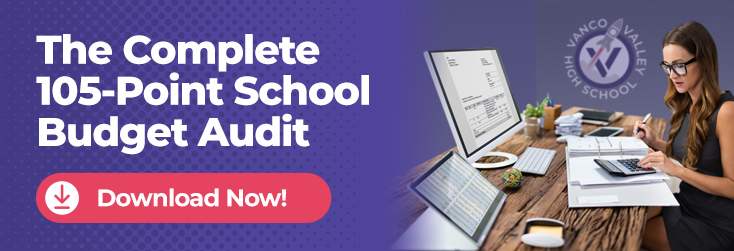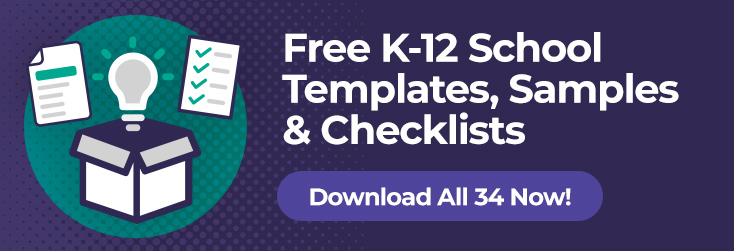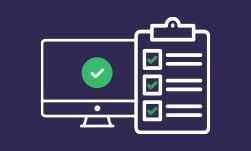 Funding for K-12 schools has faced financial challenges for decades. Federal funding for US schools was on a steady decline when the American Recovery and Reinvestment Act (ARRA) of 2009 was implemented. Even with an infusion of billions of dollars, schools continue to struggle.
Funding for K-12 schools has faced financial challenges for decades. Federal funding for US schools was on a steady decline when the American Recovery and Reinvestment Act (ARRA) of 2009 was implemented. Even with an infusion of billions of dollars, schools continue to struggle.
States and school districts have had to learn how to create effective school finance management plans and figure out best practices for financial accounting for schools. It isn't an easy task for school districts strapped for cash and experiencing budget cuts, which are important aspects of the school budgeting process.
School financial offices aren't only tasked with balancing budgets. They also must manage and approve contracts, ensure vendors are paid in a timely manner and oversee asset management.
States have academic standards they are obligated to meet. When schools are underfunded, it becomes an upward climb to ensure student success. With school choice, individual schools are subject to decreased funding as students withdraw and enroll in charter and private schools.
Are you interested in learning more about school finance management for K-12 schools? Keep reading to learn more as we walk through financial management in public schools.
The Role of School Principals in School Finance Management
School districts operate differently around the country, and each has its own rules on who is responsible for the distribution of funds. In more cases than not, once those funds are distributed to the school, the school principal plays a big part in how money is spent.
The role of a school principal in financial management is bigger than most people may think. Look at schools as micro-businesses or departments operating within silos. Principals are competing for budget dollars, headcounts and control over the direction of their school.
The school district determines how much money is allocated to schools. In most states, the allocation of funds is based on per-student amounts. Additional funding is given to schools with high student populations coming from low-income neighborhoods. Other schools get increased funding for hosting magnet programs.
School principals have four primary duties under school finance management.
Create a Budget for Their School
Consider it a budget within a budget within a budget. States distribute funds to school districts. The districts create a budget and divvy money to its schools. The principal is then charged with setting a budget for their location.
The district sets the guidelines on how funds are allocated. There are items a principal can include in their budget, and things they cannot.
School budgets must get approval from the district's accounting office.
An effective budget is one driven by obtainable action items geared towards the success of the students and staff. If the principal is acting as the CEO of a business, they understand their overall success is dependent on reaching the school's overall objectives, paired with state objectives.
The shareholders are the taxpayers and when the school fails it's a sign of poor or ineffective leadership. Therefore, a principal is held to a high standard and can get reassigned or demoted at the discretion of their superiors.
Manage Teacher Salaries
How much flexibility a principal has when it comes to teacher salaries is dependent upon how the school district operates. Some districts have pay scales, while some have set percentage ranges based on evaluation levels. In most cases, the principal has set standards on how much of the budget is allotted to teacher salaries.
Oftentimes, some school personnel falls under the budget of different departments. For example, school maintenance personnel are under building maintenance and assigned to various schools. The same can apply to administrative staff.
Principals still play a role in the evaluation process which impacts the district's overall payroll budgets.
Oversee Fundraising Activities
As schools look for creative ways to stretch their budgets, fundraising remains a high priority. Without it, many clubs and extra-curricular activities would suffer tremendously or cease operation.
Principals are hired to run schools, not to become the creator, organizer and collector of fundraisers. What ends up happening is schools rely on Parent Teacher Associations (PTA) and booster clubs to fundraise.
Although students, clubs and sports teams are the driving force behind bringing in revenue, the principal is responsible. They must ensure all activities are within the boundaries set by the district. They must approve any products or services being sold in online stores or online fundraisers.
In addition, when fundraisers are held off-campus or involve sponsors and advertisements, the principal must sign-off on it.
Keep Accurate Accounting
School districts have accounting departments that have financial management software. Principals and staff members are required to keep accurate accounting by utilizing this software. They cannot create their own records management outside of mandated programs.
To avoid improprieties, schools are assigned bookkeepers or accounting specialists whose job functions include recording financial transactions. This is a check and balance put in by the district to ensure every dollar is accounted for and money is calculated with accuracy.
How to Get Communities to Buy In
There's a lot that goes into financial management in public schools. Several factors affect school spending. Everything from public policies to the state of the economy is crucial to funding.
There is little districts can do to affect the larger issues, but there are approaches to effectively manage school resources. Let's look at a few.
1. Develop Community Partnerships
Local school districts must have community partners. They're in the business of educating children. These children have parents that are business owners. Who run and attend local churches and belong to civic organizations.
Who has the greatest incentive to rally behind institutions of education than the people who rely on them?
Community partnerships are useful when it comes to fundraising, supporting sports teams and civic clubs. These partnerships become instrumental in addressing new policies and legislative changes.
2. Stay Abreast of Policy Changes and Communicate via Public Forums
It is vital to stay abreast of legislation that will impact your school district. This information has to get disseminated quickly, so districts are not caught off guard. The same is true for local districts making changes to school budgets within their control.
The best way to deal with these changes is to get information out to the community via public forums. In some places, voters must approve measures that affect the budget of local school systems. By keeping the lines of communication open, you increase the prospects of a favorable outcome.
Too often, people show up for major elections and opt-out of mid-term elections which have more local initiatives on the ballot. Even then, they don't appear to give much thought to local amendments.
Informed voters will show up at the polls to support causes they believe in. They will also get others to participate in the process.
3. Remain Transparent
Open communication is as important today as it's always been. Transparency is the key to good communication. Understand your audience and build effective ways to relay information at a level that's easy to understand.
Explaining initiatives to administration staff is different than delivering the message to educators. The same is true when it comes to speaking to parents.
The person delivering the message has to take the information and create messaging, images, videos, etc., based on who they are talking to. This means 20 principals may have 20 different PowerPoints, but the facts must remain the same.
How to Manage School Finances Effectively
There are ways schools can manage school finances effectively both inside the school and at the district level. It's a joint effort and everyone has to make a contribution.
1. Eliminate Excess Spending
Both the district and principals can eliminate excess spending. Take a good look at your budgets and see what you can cut that doesn't negatively impact the learning process.
Don't take it upon yourself to decide what should get cut. Get input from your district employees, school staff and the community.
Review employees and job descriptions. Assistant principals earn higher pay than Deans of students. Instead of hiring an AP for each grade level, opt for a less expensive role.
Look to your local colleges that have teaching programs. Fill vacant teaching assistant roles with college students in need of credit hours.
Maintenance departments can rotate personnel to different campuses based on need.
2. Set Milestones
Financial management in public schools has to have the means to measure success. The best way to measure a goal is by setting milestones.
If you're trying to cut excess spending and operate in financial efficiency, the best way to do it's by having clear expectations and obtainable goals. Some goals are short-term while others are long-term.
Districts must communicate their overall plan to every school. They are also responsible for following up and developing a response when goals aren't met. Perhaps their goals were too ambitious. On the flip side, the people responsible for doing the work did measure up.
The same is true for principals. There has to be consequences or adjustments when your school doesn't meet expectations.
3. Implement Ongoing Evaluation of Spending Goals
Once spending is under control, the next step is to evaluate ongoing spending and ensure schools and the district office aren't drifting back into old spending habits.
It's all about constructing a new normal. See what worked naturally in your overall plan for financial management and improve on it. If there were goals that weren't easily obtainable or caused a downward shift in processes, they are reviewed, revised or eliminated.
4. Consider Operational Partners
Schools are in the business of educating students. However, a large portion of school district budgets is spent on roles that have nothing to do with education. Can schools benefit from business partnerships?
Businesses of all sizes have figured out there are positions and even full departments that don't require full-time staff or departments. Some outsource and others consolidate roles.
Some businesses believe they saved money in the long run. They also get exposed to a better talent pool.
Let's take a quick look at how school districts can incorporate this idea into financial management in public schools.
1. Information technology is probably the biggest industry for entering into service partnerships. Big savings could come in the form of exploring options for help desk services. This alone could potentially create savings in the IT budget.
2. School lunch programs are a safeguard for the health and wellbeing of children. The schools understand that in some instances, these may be the only meals some children receive all day.
At the high school level, an option to explore is also a way for schools to make money. They should consider vending machines at high schools, or a la carte options provided by an outside vendor.
3. Schools already outsource security. Many districts have partnerships with local law enforcement agencies. Others use private security firms.
5. Incorporate Accounting Software for Schools
Implementing accounting management software into school finance management offers a great return on investment. These programs help streamline processes in different areas of the school's accounting responsibilities.
These programs offer several features. The most valuable tool is the ability of parents and vendors to submit payments online.
Eliminate the need for parents to send money to the school via their children who may forget to turn it in. Or worse, decide to use it for something else. With the software, parents can pay for:
- school meal programs
- sports fees
- field trips
- overdue library fees
- PTA dues
- school pictures
- AP exam fees
- and more
Within their individual accounts, they can see records or their payments and receive receipts. For school lunches, they know when it's time to reload food cards.
The ease and convenience of using the software increase the likelihood that payments will be made and submitted on time.
6. Implementing Change
The most cost-effective solution should always receive full consideration. When it comes to implementing new ideas, expect push back from school personnel and parents. It's human nature to resist change.
At the end of the day, school districts must make the best decisions for the good of the majority. On the most basic levels, these changes might not seem like a lot, but over time, you'll have measurables to show cost-savings.
How Does Equity and Adequate Education Impact School Finances?
Is it a fair assessment that schools serving an abundance of students from low-income neighborhoods require a greater budget and resources? Do schools in affluent neighborhoods where resources are readily available outside of school deserve a lower budget?
These two topics have been at the top of discussions surrounding equity and adequate education. The reality is, school districts rely on federal funding that addresses education disparities in terms of societal influences. This is where programs like Title I, which provide funding for economically disadvantaged students, come into play.
Let's take a look at how school finance management must make room for equity and adequate education.
What Does Equity in Education mean?
In its basic form, equity means each school district throughout the state offers the same resources to its students. Resources include books, technology, software and learning environments.
Federal and state laws address equity to assure schools in low-income neighborhoods have the same access as everyone else. Access in terms of equity doesn't mean each student receives identical resources. It's a reality that students have different needs and there are various tools available to reach the desired outcomes.
There are two levels in which financial management in public schools are measured when it comes to equity. The first is to compare equity among districts. The second is to measure equity among schools within individual districts to ensure all students receive equal funding.
What is Adequacy in Education?
Adequacy in education are reassurances that states have outlined and have clear definitions of what quality looks like in their school systems. These items must be available and obtainable by each student.
Adequacy is sometimes seen as a low bar or standard for districts to meet. It also can become an argument for those challenging equality in school systems. For example, if every school is required to provide each student with a tablet, does it mean the tablets are the same make, model and year.
Or does it simply mean each student gets a tablet regardless of cost or quality?
Where Do Equity and Adequacy Cross Paths?
School districts have a separation of equity once it gets to the local level. Local governments have their own tax base and set their own budgets. Whereas school funding for K-12 public schools may start off equal, they could vary once local taxes are fed into the budgets.
It doesn't take rocket science to understand that certain communities have a higher tax base solely because monies are coming from property taxes.
For the sake of this article, let's say with federal and state funding, each student is allotted $7,500. However, district A gets a boost of $2,500 per student. Yet, district B gets $5,000, and district C, $7,500.
Now the poorest district has $10,000 per student, and the richest district has $15,000. The creates an imbalance in the theory of equity and adequacy. Why? Because the district receiving $15,000 now has more resources for things like:
- recruitment
- technology
- books
- supplies
- funding for athletics
- building maintenance
- and more
Of course, there are school administrators gifted on how to manage school finances effectively. They can take the $10,000 and provide comparable resources by negotiating discounts. Their biggest successes come in recruiting teachers whose passion for teaching underprivileged students supersede their desire to earn higher pay.
Placing Core Educational Services First
Core educational services in education are sometimes elusive in school districts of moderate and high-income families. They're more valuable to students in low-income communities to bridge the gap between communities.
We've talked about gaps between districts and states. However, there are also gaps in counties that have multiple school districts. School boards seat members to represent these districts, and it's common to find underserved schools because of societal conditions.
Core services needed for these subcommunities includes:
- Early childhood education programs to give families access to education.
- Funding to recruit teachers with experience and training in Title I schools.
- The opportunity to have advanced placement courses and magnet programs offered at these schools.
- Contracting with providers to offer before and after school programs.
Keep in mind there has to be financial grants in place to assist parents who can't afford fees for programs.
Managing Resources and Innovative Thinking is the Key to Success
Federal, state and local mandates aren't going anywhere. They are there to protect schools and to ensure children receive every advantage afforded to them. The best financial success stories come from districts and schools that have figured out how to manage school finances effectively.
There's a lot to consider and every decision impacts someone or some department. School district employees, community members, parents and students are all stakeholders. Their input is valuable and needed.
Changes, whether big or small make a difference. Remember to set measurable goals and follow timelines. Always be prepared to make decisions if they will help reduce operational costs without causing harm to the staff and students.
Get All the Must-Know School Finance Management Tips!
Download the complete school finance guide for free, which also includes key cost-saving measures your school can take to keep a healthy budget.















.jpg?width=450&height=250&name=34-K-12-School-Templates_thumbnail%20(1).jpg)




